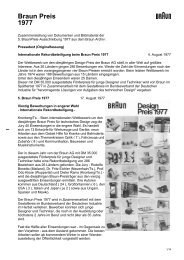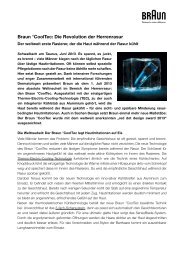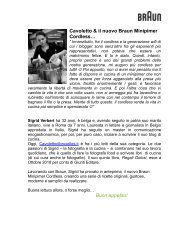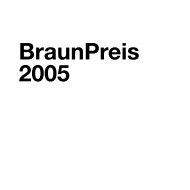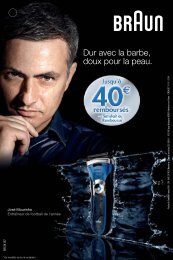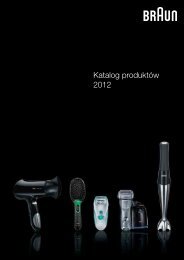BraunPrize 2003
BraunPrize 2003
BraunPrize 2003
You also want an ePaper? Increase the reach of your titles
YUMPU automatically turns print PDFs into web optimized ePapers that Google loves.
<strong>BraunPrize</strong><br />
<strong>2003</strong><br />
The Braun employee magazine, special issue | February 2004 | English<br />
<strong>BraunPrize</strong> Special 17
Bernhard Wild<br />
Chairman of Braun, Kronberg<br />
Helmut Lübke<br />
President of the German<br />
Design Council, Frankfurt<br />
Achim Pohl<br />
‘ARTEFAKT industriekultur’<br />
Darmstadt / Germany<br />
1989: <strong>BraunPrize</strong> winner,<br />
1986: Project shown in<br />
<strong>BraunPrize</strong> Exhibition<br />
2 <strong>BraunPrize</strong> Special<br />
Viewpoints<br />
The <strong>BraunPrize</strong> can now look back on a long<br />
tradition – a tradition which has not always<br />
been easy to uphold. Over the decades, the<br />
<strong>BraunPrize</strong> has evolved, as have the themes<br />
which have captured the imagination of<br />
the design world. At present, lifestyle and<br />
leisure-related topics are particularly in<br />
vogue. We established the <strong>BraunPrize</strong> Forum<br />
to bring on board the ideas and opinions<br />
of a wide spectrum of international experts.<br />
When the members of the Forum vote they<br />
are making an important contribution to the<br />
future of design by encouraging and moti-<br />
vating a new generation of designers. In<br />
simple terms, Braun gives young designers a<br />
fair chance to make a name for themselves.<br />
The success of the <strong>BraunPrize</strong> in encoura-<br />
ging design talent is also reflected by the<br />
fact that many former participants have gone<br />
on to become well-known design figures.<br />
The <strong>BraunPrize</strong> demonstrates Braun’s<br />
exemplary commitment to design training<br />
at international level. The high standards<br />
expected of the participants drive them<br />
to develop their own skills for integrating<br />
technology and design. By promoting<br />
cross-functional thinking and teamwork the<br />
<strong>BraunPrize</strong> is still as relevant today as it<br />
was when it was established some 35 years<br />
ago.<br />
If you are a student or just starting out on<br />
your career, competitions represent an<br />
important opportunity – perhaps the only one<br />
– for you to position yourself and make a<br />
mark at international level. The <strong>BraunPrize</strong>,<br />
which combines an exceptionally consistent,<br />
career-focused outlook with the international<br />
prestige of the Braun brand is obviously<br />
extremely important. Looking back, I would<br />
say that the <strong>BraunPrize</strong> had a major influence<br />
on my development as an industrial designer.<br />
There is no doubt that winning in 1989 –<br />
and the international recognition which<br />
this achievement brought with it – greatly<br />
boosted my self-confidence and helped me<br />
decide to set up an independent design<br />
studio – ‘ARTEFAKT industriekultur’.<br />
The <strong>BraunPrize</strong> continues to attract an ex-<br />
tremely positive response, both with regard<br />
to the design competition itself and the<br />
biennial Forum event. Much of this success<br />
is due to the fact that the participants and<br />
guests sense that Braun’s support for the<br />
competition stems from its honest, genuine<br />
commitment to a good cause to which it<br />
brings the high standard of quality typical of<br />
the company. But it is also a consequence<br />
of the way the competition entries reflect the<br />
<strong>BraunPrize</strong> theme of ‘Dream real products!’<br />
by embodying a successful synthesis of<br />
vision and feasibility which is also relevant to<br />
people’s everyday lives. The product con-<br />
cepts in the <strong>BraunPrize</strong> Exhibition testify to<br />
the high quality of industrial design training<br />
which offers a real sense of direction both in<br />
theoretical and practical terms. We view the<br />
extremely high level of acceptance which<br />
the <strong>BraunPrize</strong> enjoys around the world as<br />
confirmation of the importance of our<br />
commitment.<br />
The <strong>BraunPrize</strong> represents the diversity of<br />
design and the emerging directions that<br />
design is taking as embodied in the work of<br />
graduates of design schools from around<br />
the world. As such the prize becomes a<br />
barometer of design innovation culture and<br />
is critical to professionals, industry, stu-<br />
dents and the public as a whole. The<br />
<strong>BraunPrize</strong> gives us all a glimpse of the<br />
potential of tomorrow.<br />
The best entries in the <strong>BraunPrize</strong> com-<br />
petition <strong>2003</strong> had an ethical undertone and<br />
social consciousness. They were not only<br />
designed for the nearest and dearest but for<br />
everyone in order to improve the quality of<br />
everyday life and thus enhance the welfare<br />
of people. By taking this step of social<br />
responsibility one can say that these young<br />
designers have a shared attitude in the<br />
profession: the ethic of caring. I feel proud<br />
of these young designers they have under-<br />
stood the real role of a designer. Like<br />
Finnish designer Kaj Franck had said: “Is it<br />
the ultimate meaning of the beauty to be<br />
essential, functional, justified, correct?”<br />
That was also my guideline to evaluate the<br />
entries. And I think that all the proposals in<br />
the Braun Prize exhibition fulfil this state-<br />
ment about aesthetic and ethic values.<br />
Peter Schneider<br />
Director Corporate Design,<br />
Braun, Kronberg<br />
Luigi Ferrara<br />
ICSID President and<br />
Director, SCHOOL OF DESIGN,<br />
George Brown College,<br />
Toronto<br />
Anne Stenros<br />
Managing Director,<br />
Design Forum Finland,<br />
Helsinki
Contents<br />
Viewpoints 2<br />
The <strong>BraunPrize</strong> 3<br />
The jury and its work 4<br />
The <strong>BraunPrize</strong> Forum 5<br />
The finalists 6<br />
The award ceremony 8<br />
The exhibition 10<br />
The exhibitions 15<br />
<strong>BraunPrize</strong> Special <strong>2003</strong><br />
Published by: Braun GmbH, Kronberg<br />
Responsible for the <strong>BraunPrize</strong>: Peter Schneider,<br />
Corporate Design<br />
Produced and edited by: Birte Cobarg, Corporate Public<br />
Relations, and Gerlinde Kress<br />
Production and editorial support: Cornelia Heymann<br />
Design: Sonja Schmitt, Corporate Design<br />
Printed by: Lind & Ahlfeldt GmbH, Wiesbaden<br />
The <strong>BraunPrize</strong><br />
Established in 1967 at the initiative of Erwin Braun,<br />
one of the sons of the company’s founder, the<br />
<strong>BraunPrize</strong> was Germany‘s first international competition<br />
to promote the work of young designers.<br />
As a company which had frequently been honored<br />
for its successful product design, Braun wanted<br />
to give design a higher public profile and encourage<br />
its integration in everyday life.<br />
<strong>2003</strong> saw the <strong>BraunPrize</strong> awarded for the<br />
14th time. Throughout its more than 30-year<br />
history – during which the support of the<br />
Gillette Company (Braun’s parent) has<br />
guaranteed the sustained success of this<br />
renowned competition – the <strong>BraunPrize</strong><br />
has been characterized by a strong sense of<br />
continuity in its essential features.<br />
It has been dedicated to young designers<br />
since the very start. Only young industrial<br />
designers who are still studying or who have<br />
graduated within the previous two years<br />
can take part. As always, the competition is<br />
not restricted to particular product fields<br />
and is entirely independent of the Braun<br />
product range. Participants are expected to<br />
come up with product concepts which are<br />
innovative in terms of design and technology<br />
and which help people in their everyday lives.<br />
Since 2001, the theme of the <strong>BraunPrize</strong><br />
has been ‘Dream real products!’ – a concept<br />
which was developed with students from<br />
the Munich University of Applied Sciences<br />
and which combines vision and real world<br />
feasibility. An international jury featuring<br />
top design figures submits the entries to an<br />
expert assessment. Past jury members<br />
have included Otl Aicher, Sir Misha Black,<br />
Dieter Rams, Kenji Ekuan, Alessandro<br />
Mendini, Yuri B. Soloviev, Ross Lovegrove<br />
and Anne Stenros.<br />
As the <strong>BraunPrize</strong> is very much an interna-<br />
tional competition, it offers young designers<br />
and their design schools an opportunity to<br />
see how they fit into the international design<br />
scene. At the same time, they are able<br />
to benefit from the prestige and high media<br />
profile of the competition. Some 20 – 30<br />
of the top entries in each competition are<br />
selected for inclusion in a touring exhibition<br />
which visits different venues in Germany<br />
and beyond. The success of this initiative is<br />
confirmed by the ever increasing public<br />
interest which it attracts.<br />
<strong>BraunPrize</strong> Special 3
4 <strong>BraunPrize</strong> Special<br />
The jury and … its work<br />
The <strong>BraunPrize</strong> Jury has always featured leading figures from the<br />
world of design. The traditionally small size of the jury (four members)<br />
makes communication easier and allows the members to focus on<br />
the details, yet still work efficiently. It is also traditional for the head<br />
of Design at Braun to chair the jury: up to 1989 Dr. Fritz Eichler,<br />
up to 1995 Prof. h.c. Dieter Rams, thereafter Peter Schneider.<br />
Anne Stenros, Managing Director of Design<br />
Forum Finland, studied architecture in<br />
Finland and California. In 1992, she received<br />
her doctorate from the Helsinki University<br />
of Technology. She has been Managing<br />
Director of Design Forum Finland since 1995<br />
and is Editor-in-chief of the magazine<br />
“Form Function Finland” and the yearbook<br />
“Design in Finland”.<br />
Alexander Manu, Principal of Axis Group<br />
International in Toronto, studied industrial<br />
design at the Institute for Fine Arts in<br />
Bucharest and was elected to the Royal<br />
Canadian Academy of Arts (RCA). He esta-<br />
blished Axis Group International in Toronto<br />
in 1980 and works as a designer and author<br />
as well as teaching at the Ontario College<br />
of Art and Design.<br />
Left to right: Rainer Silbernagel, Anne Stenros, Peter Schneider, Alexander Manu<br />
Rainer Silbernagel, Director New Product<br />
Engineering at Braun, studied micro-<br />
technology, technical optics and medical<br />
technology at Frankfurt am Main University<br />
of Applied Sciences. He joined the Product<br />
and Industrial Engineering function at<br />
Braun in 1988 and has been in charge of it<br />
since 1995.<br />
Peter Schneider, Director Corporate Design<br />
at Braun, studied industrial design at the<br />
Folkwangschule in Essen. One of the winners<br />
of the <strong>BraunPrize</strong> in 1972, he has worked<br />
in the Design Department at Braun since<br />
1973 and took over as its head in 1995.<br />
He has been chairman of the jury and<br />
responsible for the <strong>BraunPrize</strong> since 1999.<br />
The <strong>2003</strong> <strong>BraunPrize</strong> attracted 558 entries<br />
from 52 countries – a new record! For<br />
the first time, the entry documents could be<br />
submitted by uploading directly to the<br />
<strong>BraunPrize</strong> server. The fact that only 42% of<br />
the entries were submitted by traditional<br />
mail shows how much easier the electronic<br />
entry facility makes it for entrants from all<br />
over the world to participate.<br />
1st jury session, German Design Council, Frankfurt 2nd jury session, Civic Hall, Kronberg<br />
At the first jury session, which took place<br />
from April 1 – 3, <strong>2003</strong> at the German Design<br />
Council in Frankfurt, the entries (which<br />
could be identified only by means of an<br />
anonymous number) were assessed on the<br />
basis of project descriptions, design<br />
sketches, technical drawings and photos.<br />
The jury selected 58 entries from 21<br />
countries to go through to the second round.<br />
At the second jury session, which took<br />
place in Kronberg from June 2 – 4, <strong>2003</strong>,<br />
the assessment was based on the design<br />
models. After an in-depth exploration<br />
of the concepts and the way they had been<br />
implemented, the jury nominated the<br />
four best entries for the final round at the<br />
<strong>BraunPrize</strong> Forum as well as 18 other<br />
projects for the <strong>BraunPrize</strong> Exhibition.<br />
Assessment criteria<br />
• Design, innovation, aesthetics, clarity, usability<br />
• Technology – how convincing is the product functionality?<br />
• Usability – the benefit which the product provides for the user<br />
Additional aspects<br />
• The clarity of the content<br />
• The quality of the presentation and the design models<br />
• A thorough analysis of conditions and needs<br />
• The feasibility of the concept with regard to processes and costs<br />
• The social acceptance of the product idea<br />
• The environmental compatibility of the product concept
Nils J. Tvengsberg (ICSID,<br />
Mexico), Kaarina Pohto<br />
(ICSID, Finland),<br />
Gianfranco Zaccai (Design<br />
Continuum, USA)<br />
The <strong>BraunPrize</strong> Forum<br />
Braun Chairman Bernhard Wild was able to welcome no less than 165<br />
guests from 28 countries to the <strong>BraunPrize</strong> Forum on September 15,<br />
<strong>2003</strong>. They had gathered at Braun‘s headquarters in Kronberg to cast<br />
their „guest juror“ votes to determine which of the four finalists was to<br />
become the overall winner of the 14th <strong>BraunPrize</strong>. The presence of<br />
leading figures from the world of design, as well as industry and media<br />
representatives with a special interest in design, reflected the importance<br />
they attached to encouraging young design talent.<br />
<strong>BraunPrize</strong> Forum<br />
The new concept for the <strong>BraunPrize</strong> Forum<br />
which was established two years ago seeks<br />
to involve a wider public in the process<br />
of choosing the winner, to take account of<br />
‘the finalists’ design communication skills<br />
(which are essential in a professional design<br />
context), and to provide scope for the young<br />
designers to make important contacts.<br />
Peter Schneider, Head of Braun Design,<br />
helped focus the guest jurors’ thoughts on<br />
the matter in hand by outlining important<br />
aspects of design in general and the Braun-<br />
Prize in particular. The other members<br />
of the jury gave brief assessments of the<br />
competition.<br />
Matthias Lossau, finalist<br />
It goes without saying that the presentations<br />
by the finalists were the main event at the<br />
<strong>BraunPrize</strong> Forum. In fact, they were all<br />
<strong>BraunPrize</strong> winners because their projects<br />
had already measured up to the rigorous<br />
criteria applied by the jury. But, because<br />
there could be only one overall winner,<br />
there was one final challenge ahead: all the<br />
finalists had to present their respective<br />
Mathias Durisch, Moritz Schlatter, finalists<br />
projects in person. This stage of the<br />
<strong>BraunPrize</strong> recognizes how important it is<br />
becoming for designers to be able to put<br />
across the qualities of their own projects in<br />
the course of their daily work. The finalists<br />
had only 10 minutes to present their projects<br />
– just as they would in a real world work<br />
situation. Despite the daunting prospect of<br />
addressing such a well-informed audience,<br />
all the finalists completed this task with<br />
style and élan – not least, thanks to the<br />
excellent guidance provided by Prof. Othmar<br />
Wickenheiser from Munich University of<br />
Applied Sciences.<br />
Using slides and videos, the candidates<br />
were able to explain the advantages of their<br />
respective concepts, document the deve-<br />
lopment of their projects and win over the<br />
expert audience with their enthusiasm.<br />
Once the presentations were over, the guest<br />
jurors still had enough time before the<br />
vote to take a close look at the design<br />
models and put detailed questions to the<br />
finalists. The finalists and their projects are<br />
presented on the following pages.<br />
Andrew Langer (Lowe &<br />
Partner, USA), Bernhard Wild<br />
(Chairman of Braun), Sylvia<br />
and Friedrich von Metzler<br />
(Bankhaus Metzler, Frankfurt)<br />
<strong>BraunPrize</strong> Special 5
6 <strong>BraunPrize</strong> Special<br />
The finalists<br />
Electricity monitoring system<br />
The electricity monitoring system makes<br />
domestic power use visible and thus gives<br />
users the information they need to control<br />
and reduce their electricity consumption.<br />
Avalanche survival airbag<br />
This concept takes the form of an airbag<br />
for skiers which can improve the chances<br />
of surviving an avalanche. It assists the<br />
rapid location and recovery of the wearer.<br />
Able to maintain a body weighing 100 kg<br />
on the surface of an avalanche in progress,<br />
It measures the power consumption of<br />
individual appliances and transmits the data<br />
wirelessly to a central unit where it can be<br />
read off.<br />
Statement of the jury<br />
There is a growing need for consumers<br />
to be able to visualize invisible things in order<br />
to save energy and, in turn, save money.<br />
The design of this project is almost perfect,<br />
not least thanks to the extremely convincing<br />
way it has been researched, analyzed<br />
and implemented. Combinations of features<br />
allow for a range of uses: the screen can<br />
be seen from many angles when mounted<br />
on the wall, or you can carry it with you.<br />
The designer used a very aesthetic approach;<br />
with that in mind, there could be some<br />
further refinements of functional and ergono-<br />
mic elements.<br />
it reduces the depth to which the wearer<br />
is ried. The airbag also features an extra-<br />
large neck-brace element, a rigid plastic shell<br />
to protect the wearer‘s back, and a folding<br />
shovel.<br />
Statement of the jury<br />
This is a very well designed solution that<br />
considers the specific issues relating to<br />
high-risk winter activities. More and more<br />
people are using their free time in pursuit<br />
of extreme sports as a lifestyle choice and<br />
this is where this project, which can be<br />
regarded as a leisure product, fits in. The<br />
growing trend for outdoor and adventure<br />
activities is being accompanied by an<br />
increase in the number of people losing their<br />
lives in climbing accidents and as a result<br />
of avalanches. This product seems to be<br />
well researched and is an improvement<br />
on existing airbag systems. It provides a hard<br />
shell design that offers additional strength<br />
and therefore additional protection.<br />
Michelle DesGroseilliers<br />
Ontario College of Art &<br />
Design, Canada<br />
Mathias Durisch,<br />
Moritz Schlatter<br />
Hochschule für Gestaltung<br />
und Kunst, Zürich, Switzer-<br />
land
‘Modio’ – Internet radio<br />
Modio is an internet radio system which<br />
consists of two parts: the radio itself and an<br />
oval shell containing the speakers. As well<br />
as allowing users to receive internet radio<br />
stations, play CDs/DVDs and receive home-<br />
cinema soundtracks, it features a text/video/<br />
voice communication module. The portable<br />
‘ct.loop’ – Computer tomograph<br />
ct.loop is a computer tomograph whose<br />
open formal concept and friendly color<br />
combinations make the business of under-<br />
going a scan less stressful for the patient.<br />
unit, which can be used by several people<br />
simultaneously, has a wireless link to the<br />
wall-mounted speaker module.<br />
Statement of the jury<br />
This project offers a new approach to a<br />
classic home product and represents an<br />
effort to rethink what a radio is. The tradition<br />
of the radio occupying a central role in the<br />
home has been brought back by this design,<br />
this time with added technological advan-<br />
tages. The unit comprises a computer,<br />
keyboard, display, video camera and wire-<br />
less online connectivity as well as traditional<br />
radio components such as speakers. This is<br />
both a modern piece of technology and a<br />
piece of art which the user can hang on<br />
the wall. An additional benefit is the mobility<br />
of the device, which can be moved from<br />
room to room without loss of functionality or<br />
connectivity.<br />
The system is equipped with a communi-<br />
cation unit which guides the patient through<br />
the scan process.<br />
Statement of the jury<br />
The jury selected this project because<br />
of its overall depth of understanding of the<br />
topic and the clarity and intelligence of<br />
the designed solution. The concept is an<br />
improvement on the existing equipment,<br />
and a good piece of industrial design. The<br />
open and user-friendly aesthetic of the<br />
design (instead of the traditional ‘scary tube’)<br />
reduces the patient’s fear of this type of<br />
equipment. The functional and visual<br />
characteristics are well combined and<br />
complement each other. The designer has<br />
provided a clear and simple user interface<br />
for the doctor while meeting the patient’s<br />
need for emotional and physical comfort.<br />
Benjamin Holch was voted overall winner of<br />
the <strong>2003</strong> <strong>BraunPrize</strong> for his ‘ct.loop’ project.<br />
Jörn Busse,<br />
Matthias Lossau<br />
Hochschule der Bildenden<br />
Künste, Braunschweig,<br />
Germany<br />
Benjamin Holch<br />
University Essen,<br />
Germany<br />
<strong>BraunPrize</strong> Special 7
8 <strong>BraunPrize</strong> Special<br />
The award ceremony<br />
Some 500 guests from all over the world gathered in the inner<br />
courtyard of Braun’s headquarters building for the presentation of<br />
the <strong>2003</strong> <strong>BraunPrize</strong>.<br />
Inner courtyard of Braun’s headquarters in Kronberg – award ceremony<br />
Luigi Ferrara (ICSID<br />
President, Canada)<br />
Right:Judith Várhelyi<br />
(Hungarian Design Council), Emilian D. Cartis (participant in <strong>BraunPrize</strong> exhibition,<br />
Finland), Anne Stenros (<strong>BraunPrize</strong> juror, Finland)<br />
Among those who had traveled from parti-<br />
cularly far afield were a number who had<br />
attended the ICSID (International Council of<br />
Societies of Industrial Design) conference<br />
in Hanover and Berlin a few days earlier and<br />
who had taken the opportunity to stay on<br />
in Germany for the <strong>BraunPrize</strong>. Addressing<br />
the prestigious yet very informal gathering,<br />
Braun Chairman Bernhard Wild commented<br />
that the guest list read like a who’s who<br />
of the international design community.<br />
All the speakers focused on the current<br />
status of design and ways of promoting it.<br />
Bernhard Wild opened the proceedings<br />
in his capacity as host by explaining the<br />
central role played by design at Braun and<br />
describing how the <strong>BraunPrize</strong> reflects<br />
the company’s product philosophy to great<br />
effect. ICSID, the global umbrella orga-<br />
nization for industrial designers which has<br />
supported the <strong>BraunPrize</strong> since 1992,<br />
Franco Lodato (Motorola Inc., USA), Sasha Alexander<br />
(University of Western Sydney, Australia)<br />
was represented by its newly elected<br />
president, Luigi Ferrara. The director of<br />
George Brown College in Ontario, Canada,<br />
spoke about key issues relating to design<br />
promotion at international level. He<br />
was followed by Andrej Kupetz, managing<br />
director of the German Design Council,<br />
who looked back on 50 years of design<br />
promotion in Germany.<br />
The sense of anticipation increased as<br />
Peter Schneider, head of Braun Design and<br />
chairman of the jury, described how the<br />
<strong>2003</strong> <strong>BraunPrize</strong> competition had been<br />
organized and then went on to introduce jury<br />
members Anne Stenros, Alexander Manu<br />
and Rainer Silbernagel. He also presented<br />
the four finalist projects whose three-dimen-<br />
sional models were displayed prominently<br />
on the courtyard’s central water feature.<br />
Speaking on behalf of the jury, Rainer<br />
Silbernagel explained why the electricity<br />
Left: Peter Zec (Design<br />
Center NRW, Germany) and<br />
Luigi Ferrara (ICSID, Canada)<br />
Peter Schneider (Braun) and <strong>BraunPrize</strong> jurors<br />
José Cuendias Cobreros<br />
(Oficina Nacional de Diseño<br />
Industrial, Cuba) and<br />
Dieter Rams (Germany)<br />
<strong>2003</strong> <strong>BraunPrize</strong> banner<br />
at main entrance
Bernhard Wild (Chairman of Braun) and Benjamin Holch, <strong>2003</strong> <strong>BraunPrize</strong> winner, with jurors and finalists<br />
Mike Cargill (Cowes High School, USA), Brian Steinhobel (Design<br />
South Africa) and Kees Schilperoort (Brown KSDP, South Africa)<br />
monitoring system, avalanche survival<br />
airbag, computer tomograph and internet<br />
radio had made it through to the last round.<br />
The tension in the air was palpable as Peter<br />
Schneider reached for the large envelope<br />
containing the result of the vote count which<br />
had been conducted under legal supervision<br />
. “The winner of the <strong>2003</strong> <strong>BraunPrize</strong> is ...<br />
Benjamin Holch for his ct.loop computer<br />
tomograph.” Benjamin Holch was delighted<br />
as the audience applauded enthusiastically<br />
and he was presented with the <strong>BraunPrize</strong><br />
trophy and a check for € 11,000. The<br />
other finalists each received € 4666 from<br />
the total prize fund of € 25,000.<br />
The <strong>BraunPrize</strong> Exhibition, which opened<br />
immediately after the award ceremony,<br />
gave the guests an opportunity to appreciate<br />
the high standard of the entries which the<br />
finalists had been up against. The opening of<br />
the gourmet buffet, which had been<br />
Earl Powell and Karen Freeze (Design Management Institute,<br />
USA) with Bernhard Wild (Chairman of Braun)<br />
prepared with typical attention to detail by<br />
the Eurest team from the Braun staff<br />
restaurant together with food stylist and<br />
cookery writer Andreas Miessmer, marked<br />
the beginning of the more relaxed part<br />
of the evening. The guests appreciated the<br />
warm welcome they received from Braun<br />
and took the opportunity to meet old friends<br />
(some of whom had traveled from the other<br />
side of the world), make new ones and<br />
generally enjoy the convivial atmosphere.<br />
The high level of interest and the positive<br />
feedback indicate that the <strong>BraunPrize</strong><br />
has become one of the landmark events in<br />
the international design calendar. Anyone<br />
who has been involved in the <strong>BraunPrize</strong><br />
can confirm that, far from being an image-<br />
building exercise for Braun, it is the result of<br />
a genuine commitment to young design<br />
talent.<br />
Above: Benjamin Holch, <strong>2003</strong><br />
<strong>BraunPrize</strong> winner, with his<br />
project ‘ct-loop’<br />
Left: Beatriz Jimenez-Frieden<br />
(Mexico), R.C. Pulido (Pontificia<br />
Javerian University, Columbia)<br />
Maria Baretto (Designproyecto,<br />
Columbia) and friend<br />
<strong>BraunPrize</strong> Special 9
‘Pure’<br />
‘Desert wear’<br />
10 <strong>BraunPrize</strong> Special<br />
The exhibition<br />
In order to make the ingenuity and creativity of young designers<br />
accessible to a wider public, Braun organizes and finances a touring<br />
exhibition which shows the best competition entries at venues in<br />
Germany and abroad. Having a project included in this exhibition is a<br />
distinction in its own right, as the associated publicity can help<br />
further a designer’s career.<br />
As well as featuring the four projects nomi-<br />
nated for the final, the <strong>2003</strong> <strong>BraunPrize</strong><br />
exhibition includes 18 other product con-<br />
cepts submitted by young designers from<br />
12 countries. At the same time, the exhi-<br />
bition highlights the role played by design<br />
schools in the different countries concerned<br />
and provides an overview of the current<br />
status of design training around the world.<br />
… is a portable, distillation-type water<br />
purification system which runs on solar<br />
power and does not require filters. The form<br />
and structure of a leaf are the inspiration<br />
for both its design and functionality.<br />
Statement of the jury<br />
The purification of dirty water is a topic<br />
of current and growing interest. This design<br />
solution targets a consumer market,<br />
while the true potential of this design lies in<br />
the humanitarian sector. Any implemen-<br />
tation of a product of this type would need<br />
to address issues of durability and trans-<br />
portability. Its visual language should make<br />
the function self-evident as people from<br />
different cultures would be using it.<br />
The intelligence and suitability of desert<br />
clothing worn by nomads inspired the<br />
development of this concept for a protective<br />
suit for use in extreme conditions in hot<br />
regions.<br />
Statement of the jury<br />
This piece is an example of a growing<br />
trend: garments as pieces of industrial<br />
design. This is due to the arrival of a whole<br />
new generation of ‘smart’ fabrics and<br />
temperature-sensitive garments that adapt<br />
to the prevailing conditions to offer optimum<br />
functionality and maximize user comfort.<br />
Emilian Dan Cartis<br />
University of Art and Design<br />
Helsinki, Finland<br />
Shai Levy<br />
Bazalel Academy of Art &<br />
Design Jerusalem, Israel
‘Breathe’<br />
‘Carry Cool’<br />
‘The cart of<br />
work and play’<br />
‘Semi<br />
powered bike’<br />
… In addition to its role as a breathing<br />
mask which informs the wearer about<br />
air quality and provides protection in an<br />
emergency, this product represents a<br />
socio-political protest against air pollution.<br />
Statement of the jury<br />
The jury appreciated the reasoning and the<br />
social activism of the designer. The project<br />
represents a longer lasting solution and an<br />
alternative to today’s disposable products.<br />
Issues such as the choice of materials,<br />
economic feasibility and hygiene should be<br />
investigated further. It is not a perfect design<br />
solution, but demonstrates a new mindset.<br />
… is a rucksack-type cool box for trans-<br />
porting perishable or frozen food, especially<br />
on hot days.<br />
Statement of the jury<br />
The Carry Cool is a new interpretation of a<br />
portable cool box. The design of the unit<br />
has advantages over existing products. The<br />
rigid box provides good protection and<br />
keeps the contents cool for longer. Further<br />
investigation into the use of lightweight mate-<br />
rials and specifications would be required.<br />
… is both a trolley and a scooter and thus<br />
adds a fun dimension to a practical product.<br />
Statement of the jury<br />
The product demonstrates a logical and<br />
creative approach to combining two<br />
products in an intelligent way which maxi-<br />
mizes the use of energy and resources.<br />
It is a clear and functional design. Further<br />
consideration should be given to the<br />
question of size and the mechanical details.<br />
… takes a new approach both visually and in<br />
terms of technology. Conventional bicycle<br />
elements are complemented with innovative<br />
components. A fuel-cell powered auxiliary<br />
motor complements the pedal power<br />
provided by the rider.<br />
Statement of the jury<br />
The bicycle is one of the oldest post-<br />
industrial-revolution modes of transport; the<br />
use of new fuel cell technology is therefore<br />
a logical step towards a future personal<br />
transportation solution. However, the choice<br />
of conventional cycle wheels for the concept<br />
creates a conflict between the form of the<br />
bike and the styling of the wheels.<br />
Kristin Will<br />
Western Washington<br />
University, USA<br />
Jörn Busse<br />
Hochschulde<br />
für Bildende Künste<br />
Braunschweig,<br />
Germany<br />
Sung Junggi,<br />
Hyunggon Ryu<br />
Kook-min University Seoul,<br />
South Korea<br />
Johan Persson<br />
National University of Arts,<br />
Crafts and Design<br />
Stockholm, Sweden<br />
<strong>BraunPrize</strong> Special 11
‘Renergy’<br />
‘La Magia’<br />
‘What you need<br />
… to see and<br />
remember the<br />
world’<br />
Transrapid-<br />
Informationssystem<br />
12 <strong>BraunPrize</strong> Special<br />
… was created in order to demonstrate how<br />
everyday products might look in the world<br />
of 2032 where the availability of energy and<br />
other resources is limited. ‘Renergy’ is a<br />
concept for the re-use of energy in order to<br />
protect and preserve the environment.<br />
Statement of the jury<br />
The system is somewhat conceptual and can<br />
be regarded as experimental. Rather than<br />
offering one isolated solution, it includes<br />
the whole world and its systems. This is a<br />
product line in need of a consistent aesthetic<br />
language and in this respect, further con-<br />
sideration should be given to the detailing of<br />
all components.<br />
… is a self-contained coffee maker which<br />
can prepare a wide variety of coffee-based<br />
beverages quickly and easily.<br />
Statement of the jury<br />
Although it is traditionally risky to come up<br />
with a new form for a well-established<br />
product, this new concept was very well<br />
received for its special approach. Suitable for<br />
use in an office situation or in the home,<br />
the unit caters for a wide range of individual<br />
tastes. There is scope for further develop-<br />
ment of the design of the controls which are<br />
also suitable for visually handicapped users.<br />
… is a compact and robust electronic diary<br />
with a wide range of functions for people who<br />
are frequently on the move.<br />
Statement of the jury<br />
This product’s form and function represent<br />
a new typology. Reflecting the new nomadic<br />
lifestyle, it features a combination of natural<br />
and man-made materials such as wood<br />
and aluminum which enhance the sense of<br />
value. Further consideration could be given<br />
to the overall size of this ‘portable product’.<br />
… helps passengers at international<br />
airports transfer to/from the Transrapid<br />
maglev system.<br />
Statement of the jury<br />
This ‘crisp’ modular design is notable for its<br />
clear and universal visual vocabulary. The<br />
documentation is well-organized, clear and<br />
produced to professional standards while the<br />
quality of the research is exemplary. Further<br />
consideration should be given to the question<br />
of vandalism prevention.<br />
Sung Hee Han, Ju Young<br />
Lee, Mi Sun Park, Han Gil<br />
Song, Young Shin Shim<br />
Kook-min University Seoul,<br />
South Korea<br />
Michaela Wien<br />
Gesamthochschule<br />
Wuppertal, Germany<br />
Benjamin Wilson<br />
Swinburne National School<br />
of Design, Australia<br />
Volker Eysing<br />
Muthesius Hochschule Kiel,<br />
Germany
‘Katana’ –<br />
Nomadic light<br />
‘Flora’ –<br />
Intelligent medication<br />
dispenser<br />
‘time squared’<br />
Asthma<br />
inhaler<br />
… is a mobile light source which combines<br />
a traditional approach to light with new<br />
technology. Equipped with the latest LED<br />
technology and powered by a rechargeable<br />
battery, the ‘Nomadic Light’ can be used<br />
anywhere inside or outside the home.<br />
Statement of the jury<br />
The project offers an exceptional response<br />
to the need for an individual light source<br />
for individual tasks. Further development<br />
could help enhance the lighting effect<br />
and its quality.<br />
Reminders and instructions about medi-<br />
cation are provided by voice synthesis,<br />
by means of indicator lights, or in the form<br />
of text on the display.<br />
Statement of the jury<br />
This concept stands out because it pro-<br />
poses a design for an entire system. The<br />
combination of pill storage and a dispensing<br />
function in the same product is logical but<br />
the system is still too complex for elderly<br />
users. Further development work could<br />
create a more space-saving design.<br />
… represents the passage of time by means<br />
of changes in light levels and colors. Rather<br />
than counting minutes and hours, this<br />
product symbolizes the transience of time.<br />
Statement of the jury<br />
This concept looks at a real product in a<br />
different context. The simplicity of the<br />
approach is exemplary and is a character-<br />
istic which ought to be adopted more<br />
frequently in future products. More detailed<br />
product communication would be helpful<br />
as additional background information<br />
is required in order to appreciate its full<br />
impact.<br />
… is a medication inhaler specially designed<br />
for children suffering from asthma.<br />
Statement of the jury<br />
The toy-like design means that this product<br />
fits into the child‘s world perfectly. The<br />
inhalation process itself can be performed<br />
in a fun and playful way, thereby removing<br />
the fear of being regarded as an outsider. At<br />
the same time, the product provides the<br />
doctor and parents with feedback indicating<br />
whether it is being used correctly. Never-<br />
theless, care should be taken not to overdo<br />
the toy-like dimension of the product.<br />
Sander Mulder<br />
Design Academy<br />
Eindhoven, Netherlands<br />
Dana Duricekova<br />
Umeå University, Sweden<br />
Maria Dupuis, Laura Varcchi<br />
Sung-Kyun, Bai, Sung-Min Lee<br />
Domus Academy Milano, Italy<br />
Rory McGarry<br />
Ontario College of Art &<br />
Design Toronto, Canada<br />
<strong>BraunPrize</strong> Special 13
‘Hunter’<br />
‘Water-low’ –<br />
water point<br />
Citybus<br />
Cockpit<br />
Solar<br />
street lamps<br />
14 <strong>BraunPrize</strong> Special<br />
… is an environment-friendly lifestyle moped<br />
powered by a fuel cell and aimed at young<br />
users. It has no exhaust pipe, operates quietly<br />
and runs on hydrogen supplied in deposit gas<br />
bottles available from filling stations.<br />
Statement of the jury<br />
The design statement is characterized by<br />
the values of the young user group at whom<br />
the product is aimed. It has a highly visual<br />
aesthetic and symbolizes a contemporary<br />
lifestyle. However, the functionality and user<br />
benefits require greater emphasis and further<br />
investigation of the ergonomics is necessary.<br />
… sets out to encourage people to be<br />
‘more sensitive to the importance of using<br />
water sparingly’.<br />
Statement of the jury<br />
The aesthetic visual language is used to<br />
outstanding effect in order to symbolize the<br />
solution of a problem. In both visual and<br />
physical terms, the entire concept reflects a<br />
commitment to saving water and energy.<br />
There is scope for optimizing certain<br />
functional aspects<br />
… is a design concept for a bus driver’s<br />
work area which takes account of future<br />
technologies to offer a new interpretation of<br />
the driver-vehicle relationship.<br />
Statement of the jury<br />
This carefully researched project which<br />
addresses the individual needs and habits of<br />
bus drivers offers many solutions to current<br />
problems. The project would benefit from the<br />
additional depth which would be provided<br />
by a optimizing details of the controls as well<br />
as a new aesthetic language.<br />
… are the key to this street lighting system<br />
which automatically recharges with solar-<br />
generated electricity during the day.<br />
Statement of the jury<br />
This product is part of the trend for smart,<br />
self-sufficient street furniture. It represents<br />
a natural progression in the use of eco-<br />
logically and financially sound solar power.<br />
The aesthetics of the concept are cha-<br />
racterized by their clarity and intelligence.<br />
For reasons of cost, it would be advisable to<br />
use commonly available solar cells and to<br />
adjust the form accordingly.<br />
Peter Jaensch<br />
Staatliche Akademie der<br />
Bildenden Künste Stuttgart,<br />
Germany<br />
Andreas Uhrig<br />
Fachhochschule Darmstadt,<br />
Germany<br />
Jan Vietze<br />
Kunsthochschule<br />
Berlin-Weißensee,<br />
Germany<br />
Nikola Knezevic<br />
University of Arts Belgrad,<br />
Yugoslavia
Braun, Kronberg<br />
Design Forum<br />
Helsinki<br />
Museum of<br />
Applied Arts,<br />
Frankfurt<br />
The Exhibitions<br />
Immediately after the announcement of the<br />
winner and the award ceremony, Peter<br />
Schneider declared the <strong>2003</strong> <strong>BraunPrize</strong><br />
Exhibition officially open. This first public<br />
showing of the top entries attracted a great<br />
deal of interest both from Braun staff and<br />
the many visitors who came to Braun’s<br />
headquarters to see the young designers’<br />
product ideas. A large number of local<br />
residents also took the opportunity to view<br />
the exhibition at Braun.<br />
“… The ‘best’ emerged from one of the<br />
most prestigious global design competitions,<br />
the <strong>2003</strong> <strong>BraunPrize</strong>. The initiative which<br />
Braun took some 36 years ago has again<br />
highlighted the foresight and vision of<br />
this company. …” It was with these words<br />
that Dr. Hanns Schumacher, Germany’s<br />
ambassador to Finland, opened the Braun-<br />
Prize Exhibition at the Design Forum Finland<br />
in Helsinki on October 9, <strong>2003</strong>. The exhi-<br />
bition, which attracted a record 7000 visitors<br />
in six weeks, was a great success.<br />
Designed by Richard Meier, the impressive<br />
architecture of the Museum of Applied Arts<br />
in Frankfurt provided a fitting setting for the<br />
‘technical’ look and feel of the exhibits in the<br />
<strong>BraunPrize</strong> Exhibition. Many visitors took<br />
advantage of the Christmas holiday period to<br />
attend the exhibition and discover the<br />
innovative product concepts.<br />
All exhibition dates at a glance<br />
Braun GmbH, Kronberg September 15 – 25, <strong>2003</strong><br />
Design Forum Finland, Helsinki October 10 – November 16, <strong>2003</strong><br />
Museum für Angewandte Kunst, Frankfurt November 27, <strong>2003</strong> – January 11, 2004<br />
Design Austria, Wien March 26 – April 14, 2004<br />
Design Zentrum Bremen April 23 – May 23, 2004<br />
The Helsinki exhibition was opened by Hanns Schumacher, the German ambassador<br />
in Helsinki.<br />
<strong>BraunPrize</strong> Special 15
16 <strong>BraunPrize</strong> Special<br />
www.braunprize.com<br />
Since 1999, the address www.braunprize.com has provided access to<br />
a trilingual web site about the competition. All the key information<br />
about the current <strong>BraunPrize</strong> can be found there in German, English<br />
and Spanish.<br />
Furthermore, all the competitions from<br />
1967 to <strong>2003</strong> are documented on the site.<br />
Currently available in German only, the<br />
other language versions of this archive will<br />
follow starting in mid 2004.<br />
The web site also provides an interactive<br />
platform for discussions about the <strong>BraunPrize</strong><br />
and Braun Design. The <strong>2003</strong> <strong>BraunPrize</strong><br />
competition saw the inauguration of an<br />
upload portal for the electronic submission<br />
of entry documents.<br />
Quick and easy to use, this new facility<br />
allowed technical drawings, documentation<br />
and photos to be sent directly to the Braun-<br />
Prize server in digital form. As a result of<br />
this streamlined entry process – which was<br />
particularly appreciated by participants<br />
from outside Europe – the <strong>2003</strong> <strong>BraunPrize</strong><br />
attracted the highest number of international<br />
entrants in the entire history of the com-<br />
petition.<br />
Some comments<br />
from the press<br />
MacUsers (Great Britain):<br />
Design competitions are a good thing, but<br />
they can be a tad predictable. Not so the<br />
<strong>BraunPrize</strong>, established by the consumer<br />
electronics firm to recognise creative work by<br />
industrial design students. Last time the top<br />
spot went to an ultra sonic washing machine.<br />
This year’s jury, chaired by design director<br />
and 1972 winner Peter Schneider, selected<br />
ct.loop, a computer-controlled tomograph …<br />
Helsingin Sanomat (Finland):<br />
… The competition also has an educational<br />
aspect to it. Through the competition,<br />
the organisers want the participants to get<br />
a more profound understanding of the<br />
demands and practices which industrial<br />
designers face in their work …<br />
INTRADOMUS (France):<br />
Today, the projects entered for the Braun-<br />
Prize, are characterised both by innovation<br />
and an added technological value. A<br />
designated web site and chatroom, as well<br />
as a series of travelling exhibitions of the<br />
prototypes, chosen by an international jury,<br />
allows the successful young designers to<br />
present themselves to a potential public, and<br />
for that public to challenge their designs.<br />
Looking ahead to<br />
the 2005 <strong>BraunPrize</strong><br />
2005 is something of a landmark for the<br />
<strong>BraunPrize</strong>, as it will see the 15th edition of<br />
the competition. As Braun product design<br />
can look back on 50 successful years at the<br />
same time, we shall be organizing anniversary<br />
events both in Germany and abroad.<br />
The call for entries for the 2005 competition<br />
will be sent out starting on March 11, 2004.<br />
The closing date is January 31, 2005.<br />
The Braun Design anniversary event with the<br />
<strong>BraunPrize</strong> Forum and the award ceremony<br />
will take place in September 2005.



